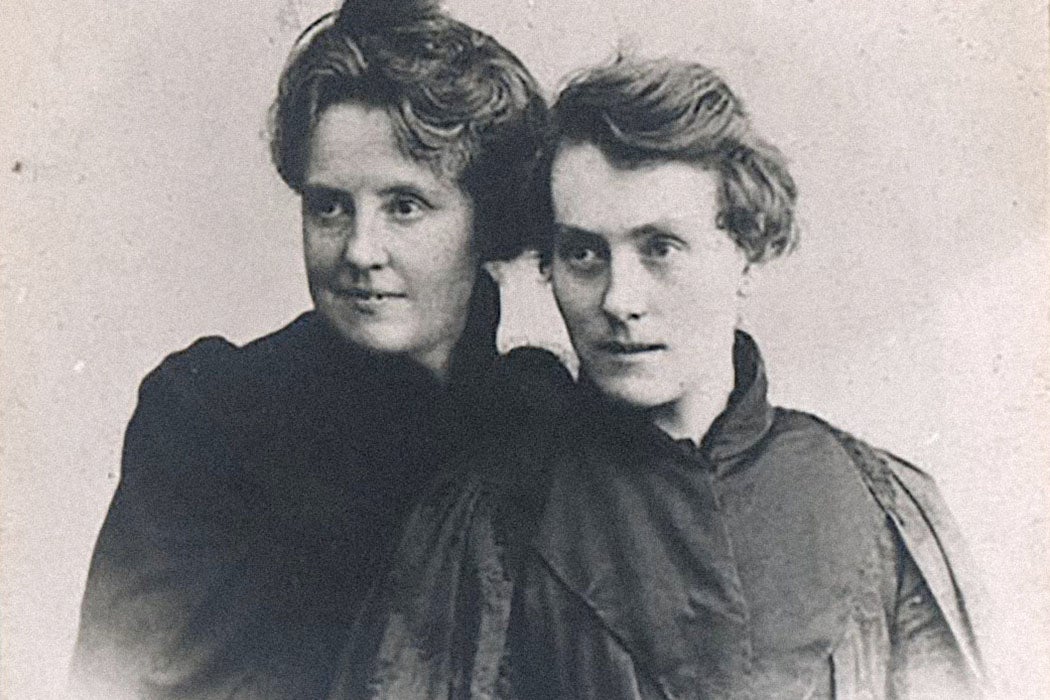Their real names were Katherine Harris Bradley (1846–1914) and Edith Emma Cooper (1862–1913). Michael Field was their joint pen name, and history can thank their fellow poet Robert Browning for outing them. Word of their secret slipped out after they had confided in him. People who are good with words, it seems, cannot always be trusted to keep their mouths shut.
The two English authors started off using Arran Leigh (Bradley) and Isla Leigh (Cooper) to publish Bellerophôn, their first full-length play, but switched to Michael Field when they realized fame and success weren’t forthcoming under those feminine aliases. Victorian women writers frequently used male pen names to conceal their true identities. A male persona protected them from the often-ruthless backlash that often accompanied any woman’s attempt to venture into the male-dominated literary world; it was simply easier to pretend to be a man and infiltrate it in disguise. Famously, sisters Charlotte, Emily, and Anne Bronte did exactly this, taking on the masculine pseudonyms Currer, Ellis, and Action Bell when they first published their poems and novels. Bradley and Cooper’s decision to share a pseudonym was a symbolic representation of the level of their closeness. They set up home together in London, worked together, and thought with one mind. They even kept a common journal, in which they recorded their ideas and daily activities. It was only natural to them that they should use only one sneaky pseudonym for their output. It was like the sealing of a pact.
Here’s where “Michael Field” may lose some potential new readers. Katherine Bradley and Edith Cooper were aunt and niece by blood. They were also a couple, and deeply in love with each other; the nature of the affection in their love letters to one another is undeniable. One might consider that they were living in a period where the options for meeting other women of similar orientation and expressing their sexuality were few. The only other lesbian writer they knew and were influenced by was the long-dead Greek poet Sappho of Lesbos. In fact, they co-authored a tribute to Sappho, which became one of the several collections that cemented their reputation. Titled Long Ago, this collection of verse, saturated with Grecian Romanticism and the female eroticism, was boldly published in 1889. Francis O’Gorman claims that “The volume proclaimed the diversity of her [Sappho’s] sexuality; it saluted verse that was connected to the self; and it urged the authenticity of her creative force in ages beyond her death.” Able to relate to Sappho both sexually and intellectually, Bradley and Cooper were proficient in writing, with exceptional success, from Sappho’s point of view. They understood her, and their awareness and solidarity as Sapphic women was transferable to their art.
And to be even more sympathetic to their personal lives, Bradley and Cooper were not deranged and murderous, like their French counterparts, the Papin sisters, nor did they ever make a public spectacle out of their unorthodox bond. They lived quite quietly and privately, maintaining a close-knit circle of literary friends and a disciplined routine of pursuing their interests. In this sense, they were closer to spirit to the famous Ladies of Llangollen, a wealthy and notoriously reclusive lesbian couple based in Wales in the eighteenth and nineteenth centuries. Victorian-age scholar Carolyn Tate’s study of Bradley and Cooper, with its point-blank title “Lesbian Incest as Queer Kinship,” makes a fair attempt to deconstruct the psychology behind this interbred romantic alliance and perhaps co-dependency. It was, she argues, a product of its time and of its circumstances. Bradley became Edith Cooper’s guardian after Cooper’s mother—Bradley’s older sister, Emma—became indisposed from physical illness following childbirth and could no longer perform her domestic duties.
Weekly Newsletter
According to Tate, in taking up the typical spinster-aunt role as the replacement lady of the house, Bradley was almost expected to create sexual strain in her sister’s repressed Victorian household, one way or another. In this particular case, rather than draw the attention of her sister’s husband, she attached herself to her sister’s daughter instead. Bradley preferred the company of women, and Edith, whom she watched grow up into a beautiful woman and talented writer, was the obvious choice. It was peculiar but bound to happen. As Tate writes, “Family affection was indeed cult-like during the Victorian period, but it was not naturalized to the point of complete acceptance. Rather, the erotic tensions within the home were fueled by the bourgeois cult of the family, and they simultaneously and paradoxically threatened the rhetoric of respectability that helped maintain middle-class hegemony.”
No one can deny that, as a writing duo, Bradley and Cooper did make a productive team, writing and publishing no fewer than forty works of poetry and verse drama. Readers who are squeamish about the incest between this controversial aunt-niece pair can at least appreciate the scale of their literary achievements, which was no dismissible feat in the Late Victorian and Edwardian eras and admire—even begrudgingly—the bravery with which they approached the taboo topic of female-to-female romance and sexuality. They are perhaps not the best representation of lesbianism in literature by the most conservative of modern standards, but it can be argued that their work paved the way for other women to write freely about their varying forms of love for each other.
Support JSTOR Daily! Join our new membership program on Patreon today.







